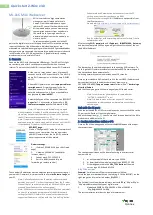
204
•
Panorama
6.1
Administrator’s
Guide
©
Palo
Alto
Networks,
Inc.
Monitor
Panorama
Administer
Panorama
Set
Up
SNMP
to
Monitor
Panorama
Simple
Network
Management
Protocol
(SNMP)
enables
access
from
an
SNMP
management
station
to
specific
Object
Identifiers
(OIDs)
or
ranges
of
OIDs
that
the
Palo
Alto
Networks
MIBs
contain
(for
a
complete
list,
refer
to
You
can
use
SNMP
to
query
the
state
of
Panorama
(SNMP
GETs)
and
trigger
alerts
(SNMP
traps)
when
events
occurs.
Panorama
supports
SNMP
v2c
and
v3.
Panorama
initiates
SNMP
traps
and
sends
them
to
the
SNMP
manager
when
a
failure
or
change
occurs
(for
example,
a
system
fan
failure),
disk
drives
are
added,
or
an
HA
failover
occurs.
Panorama
does
not
send
traps
on
a
regular
schedule,
only
when
a
triggering
event
occurs.
SNMP
GETs
allow
pro
‐
active
monitoring.
For
example,
you
can
poll
Panorama
for
trending
graphs
that
help
identify
the
following
potential
system
issues
before
a
fault
occurs:
Monitor
the
incoming
log
rate
on
an
M
‐
100
appliance
or
the
capacity
of
the
logging
disks
on
the
appliance
to
determine
if
a
Log
Collector
is
close
to
maximum
capacity.
This
information
will
help
you
evaluate
whether
you
need
to
expand
log
storage
capacity
or
add
additional
Log
Collectors.
Monitor
system
information
such
as
the
state
of
Panorama
and
which
software/content
update
versions
are
installed
(for
example,
Antivirus
version,
Applications
and
Threats
database
version,
and
Panorama
software
version).
To
set
up
SNMP
for
monitoring
Log
Collectors,
see
.
Set
Up
SNMP
to
Monitor
Panorama
Step
1
Configure
the
management
interface
to
listen
for
the
SNMP
service.
1.
Select
the
Panorama > Setup > Management
.
2.
In
the
Management
Interface
Settings
section,
verify
that
SNMP
is
enabled
in
Services
.
If
SNMP
is
not
enabled,
edit
the
Management
Interface
Settings,
select
the
SNMP
check
box,
then
click
OK
to
save
the
changes.
















































